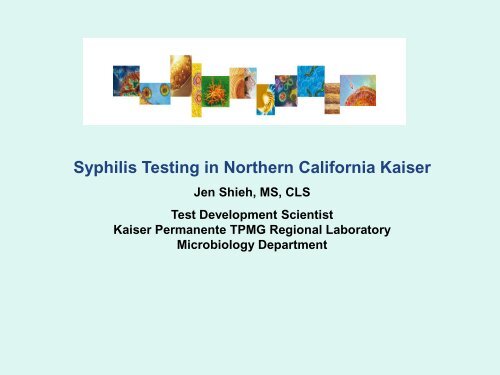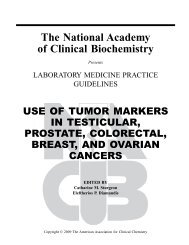Syphilis Testing in Northern California Kaiser
Syphilis Testing in Northern California Kaiser
Syphilis Testing in Northern California Kaiser
Create successful ePaper yourself
Turn your PDF publications into a flip-book with our unique Google optimized e-Paper software.
<strong>Syphilis</strong> <strong>Test<strong>in</strong>g</strong> <strong>in</strong> <strong>Northern</strong> <strong>California</strong> <strong>Kaiser</strong><br />
Jen Shieh, MS, CLS<br />
Test Development Scientist<br />
<strong>Kaiser</strong> Permanente TPMG Regional Laboratory<br />
Microbiology Department
Objectives:<br />
<strong>Syphilis</strong> Overview<br />
Validation of Liaison Treponema Assay<br />
New algorithm<br />
Guidel<strong>in</strong>e of Interpretation
SYPHILIS<br />
Caused by Treponema pallidum<br />
Transmission: sexual, maternal-fetal<br />
Increases risk of obta<strong>in</strong><strong>in</strong>g and acquir<strong>in</strong>g<br />
HIV <strong>in</strong>fection<br />
All patients with syphilis should be HIV<br />
tested<br />
Lesions of syphilis resolve without<br />
treatment although person rema<strong>in</strong>s<br />
<strong>in</strong>fected
STAGES OF SYPHILIS<br />
Primary (1-3 months)<br />
Secondary (2-6 months)<br />
Latent<br />
Early latent<br />
Late latent<br />
Late or tertiary<br />
May <strong>in</strong>volve any organ, but ma<strong>in</strong> parts are:<br />
Neurosyphilis<br />
Cardiovascular syphilis<br />
Late benign (gumma)
PRIMARY SYPHILIS<br />
Incubation period 9-90 days, usually ~21<br />
days.<br />
Develops at site of contact/<strong>in</strong>oculation.<br />
Pa<strong>in</strong>less ulcer<br />
Very <strong>in</strong>fectious.<br />
May be darkfield positive but serologically<br />
negative.<br />
Untreated, heals <strong>in</strong> several weeks, leav<strong>in</strong>g<br />
a fa<strong>in</strong>t scar.
SECONDARY SYPHILIS<br />
Seen 6 wks to 6 mos after primary<br />
chancre<br />
Usually w diffuse non-pruritic, <strong>in</strong>durated<br />
rash, <strong>in</strong>clud<strong>in</strong>g palms & soles.<br />
May also cause:<br />
• Fever, malaise, headache, sore throat,<br />
myalgia, arthralgia, generalized<br />
lymphadenopathy
LATENT SYPHILIS<br />
Positive syphilis serology without cl<strong>in</strong>ical signs of<br />
syphilis<br />
Early latent:<br />
• The first year after the resolution of primary or secondary<br />
lesions, or<br />
• A reactive serologic test for syphilis <strong>in</strong> an asymptomatic<br />
<strong>in</strong>dividual who has had a negative serologic test with<strong>in</strong> the<br />
preced<strong>in</strong>g year.<br />
• Infectious.<br />
Late latent:<br />
• Usually not <strong>in</strong>fectious, except for the pregnant woman, who<br />
may transmit <strong>in</strong>fection to her fetus.
LATE SYPHILIS<br />
‘Tertiary <strong>Syphilis</strong>’<br />
Lesions develop <strong>in</strong> sk<strong>in</strong>, bone, & visceral<br />
organs (any organ).<br />
Can be crippl<strong>in</strong>g and life threaten<strong>in</strong>g<br />
Bl<strong>in</strong>dness, deafness, deformity, lack of<br />
coord<strong>in</strong>ation, paralysis, dementia may<br />
occur<br />
slowly progressive<br />
Late syphilis is non<strong>in</strong>fectious.
Infection<br />
The Course of Untreated <strong>Syphilis</strong><br />
6 wks<br />
to<br />
6 mo.<br />
Primary<br />
(Chancre)<br />
Incubation period<br />
9-90 days<br />
Secondary<br />
(Rash)<br />
1-2 years<br />
Approx.<br />
18 months<br />
Latent <strong>Syphilis</strong><br />
(No signs of disease)<br />
Many years<br />
To a lifetime<br />
Tertiary<br />
Benign gummatous<br />
Cardio-vascular syphilis<br />
Neurosyphilis<br />
Many years<br />
To a lifetime<br />
Early <strong>Syphilis</strong> Late <strong>Syphilis</strong>
TREATMENT<br />
Primary, Secondary, Early Latent<br />
Benzath<strong>in</strong>e Penicill<strong>in</strong> G, 2.4 million units IM<br />
Penicill<strong>in</strong> Allergy<br />
-Doxycycl<strong>in</strong>e 100 mg twice daily x 14 days<br />
or<br />
-Ceftriaxone 1 gm IM/IV daily x 8-10 days<br />
(limited studies) or<br />
-Azithromyc<strong>in</strong> 2 gm s<strong>in</strong>gle oral dose<br />
(prelim<strong>in</strong>ary data)
TREATMENT<br />
Late Latent <strong>Syphilis</strong><br />
Benzath<strong>in</strong>e penicill<strong>in</strong> G 2.4 million units IM<br />
at one week <strong>in</strong>tervals x 3 doses<br />
Penicill<strong>in</strong> allergy<br />
-Doxycycl<strong>in</strong>e 100 mg orally twice daily x<br />
28 days or<br />
-Tetracycl<strong>in</strong>e 500 mg orally four times<br />
daily x 28d
Diagnosis of <strong>Syphilis</strong><br />
Darkfield Microscopy<br />
Direct Immunofluorescence<br />
Polymerase Cha<strong>in</strong> Reaction (PCR)<br />
Serology<br />
- Nonspecific (Cardiolip<strong>in</strong>-based)<br />
- Specific (Treponemal)
Serological Tests for <strong>Syphilis</strong><br />
Non-treponemal (reag<strong>in</strong>) tests<br />
- Complement Fixation Test<br />
Wasserman reaction<br />
- Flocculation Reactions<br />
Rapid plasma reag<strong>in</strong> (RPR) test<br />
VDRL<br />
TRUST<br />
Treponemal (specific) tests<br />
- FTA-ABS<br />
- TP-PA<br />
- ELISA (EIA)<br />
- Automated chemilum<strong>in</strong>escence plateforms<br />
- Current Chromatographic (POC) tests
Antibody patterns dur<strong>in</strong>g treponemal <strong>in</strong>fection<br />
1 Pope, Victoria. Infect. Med. 21 (B):339-404, 2004. ©Cliggott Publish<strong>in</strong>g, division of<br />
CMP Heatthcare Media<br />
2 Mutter F, Hagedorn HI. <strong>Syphilis</strong> <strong>in</strong>: Cl<strong>in</strong>ical Laboratory Diagnostics, Thomas L, TH<br />
Books Frankfurt 1998; 1203-12
3.2 million members<br />
22 medical centers<br />
50 MOB and cl<strong>in</strong>ics<br />
<strong>Kaiser</strong> Permanente
Microbiology Laboratory<br />
177 FTE – Micro Lab<br />
30 FTE Immuno-Diagnostic/Virology<br />
24/7 operation<br />
M-F, clean up on Saturday, Sunday Ma<strong>in</strong>tenance<br />
TrepAb/RPRQ/TPPA – 1.5 FTE,not <strong>in</strong>clud<strong>in</strong>g preanalytic<br />
and post-analytic
<strong>Syphilis</strong> <strong>Test<strong>in</strong>g</strong><br />
2008 Volume<br />
Annually: 159,744<br />
Monthly: 13,312<br />
Daily: 605
170000<br />
160000<br />
150000<br />
140000<br />
130000<br />
120000<br />
110000<br />
100000<br />
<strong>Syphilis</strong> <strong>Test<strong>in</strong>g</strong><br />
2002 2003 2004 2005 2006 2007 2008<br />
annually 131694 133584 138793 148738 155853 156612 159744<br />
monthly 10975 11132 11566 12395 12988 13051 13312<br />
daily 499 506 526 563 590 593 605
Total=2,378 RPR<br />
Validation Data<br />
+ -<br />
Liaison + 63 45<br />
- *26 2244<br />
*26- (TPPA-)<br />
45 Excluded 1<br />
Negative 10<br />
RPR-Liaison+ TPPA+ 24<br />
RPR-Liaison+ TPPA- 7<br />
RPR+Liaison+ TPPA+ 3<br />
45
Revised<br />
Total=2,377 RPR<br />
+ -<br />
Liaison + 66 31<br />
- *26 2254<br />
*26- (TPPA-)<br />
24 RPR-Liaison+ TPPA+<br />
Age: 24-81<br />
Gender: 9 Female -- 5 GYN -- 2 Prenatal<br />
7 RPR-Liaison+ TPPA-<br />
Age: 27-65<br />
15 Male -- all MED -- 9 HIV+<br />
Gender: 3 Female -- 2 GYN -- 1 Prenatal<br />
4 Male -- all MED -- 2 HIV+
Total = 2,377<br />
RPR<br />
Sensitivity & Specificity<br />
True<br />
+ -<br />
+ 66 26<br />
- 24 2,261<br />
LIAISON<br />
True<br />
+ -<br />
+ 90 7<br />
- 0 2,280<br />
RPR Liaison<br />
Sensitivity 73.3% 100%<br />
Specificity 98.6% 99.7%<br />
PPV 71.7% 92.8%<br />
NPV 98.9% 100%
7 Discrepancies<br />
# Age RPR Trep Rtrep TPPA<br />
CDC<br />
Trep-Sure<br />
CDC<br />
RPR<br />
CDC<br />
TPPA WB G WB M<br />
1 60M - P P - 2.848 P - - Bord Neg<br />
2 28F - P(1.92) P(2.1) - 1.294 P - - TND TND<br />
3 32F - P(1.18) P(1.23) - 0.018 N - - Neg Neg<br />
4 27M - P(1.83) P(1.78) - 0.396 P - - Neg Neg<br />
5 55M - P P - 2.393 P - - Neg Pos<br />
6 65F - P QNS - >3.000 P - - Bord Neg<br />
7 54M - P(1.47) P(2.9) - >3.000 P - - Neg Neg<br />
Cutoff (0.171)
No <strong>Syphilis</strong><br />
Old Algorithm<br />
RPR<br />
neg pos<br />
Do RPR Q<br />
&<br />
TPPA<br />
Report RPR titer<br />
& TPPA results
Not <strong>Syphilis</strong><br />
New Algorithm<br />
TrepAb<br />
Nonreactive Reactive or Equivocal<br />
Nonreactive<br />
Nonreactive<br />
TP-PA<br />
Reactive<br />
Further <strong>in</strong>vestigation<br />
Cl<strong>in</strong>ical correlation required<br />
RPR Q<br />
Reactive<br />
<strong>Syphilis</strong>
Treponemal<br />
Results<br />
negative (nonreactive)<br />
negative (nonreactive)<br />
positive<br />
(reactive)<br />
positive<br />
(reactive)<br />
positive<br />
(reactive)<br />
RPR Q TPPA Report/Interpretation for all except<br />
neonates or <strong>in</strong>fants<br />
not<br />
performe<br />
d<br />
not<br />
performed<br />
reactive nonreactive<br />
nonreactive<br />
nonreactive<br />
No serological evidence of <strong>in</strong>fection with T.<br />
pallidum (<strong>in</strong>cubat<strong>in</strong>g or early primary syphilis<br />
cannot be excluded)<br />
Current <strong>in</strong>fection unlikely, probability of<br />
biological false positive secondary to other<br />
medical conditions (febrile diseases,<br />
immunization, IVDU, autoimmune diseases, etc.)<br />
reactive Probably past treated <strong>in</strong>fection; additional<br />
test<strong>in</strong>g maybe necessary for cl<strong>in</strong>ical suspicion of<br />
late syphilis or neurosyphilis.<br />
nonreactive<br />
reactive not<br />
performed<br />
Probably false positive Trep Antibody result<br />
Cl<strong>in</strong>ical correlation required<br />
Evidence of current <strong>in</strong>fection (if low positive<br />
RPR with history of treatment, this is serofast<br />
state.)
U<br />
T<br />
U<br />
T<br />
<strong>Syphilis</strong> Reaction Table<br />
Reaction of Non-Treponemal Serological Test (RPR) by Stages of <strong>Syphilis</strong> and<br />
Influence of Successful Treatment<br />
Negative<br />
Negative<br />
Becom<strong>in</strong>g<br />
Positive<br />
Positive<br />
Negative Negative<br />
Positive Positive<br />
Serofast<br />
Positive<br />
(rarely Negative)<br />
Serofast<br />
Reaction of Treponemal Serological Test (TrepAB) by Stages of <strong>Syphilis</strong> and Influence of<br />
Successful Treatment<br />
Negative<br />
Positive<br />
Rema<strong>in</strong>s<br />
(If <strong>in</strong>itially<br />
Primary<br />
Primary<br />
Becom<strong>in</strong>g<br />
(early)<br />
Positive<br />
Positive)<br />
U: Untreated<br />
T: Successfully treated<br />
Early <strong>Syphilis</strong> Late <strong>Syphilis</strong><br />
Secondary<br />
Early <strong>Syphilis</strong> Late <strong>Syphilis</strong><br />
Secondary<br />
Early Latent Late Latent Tertiary<br />
Early Latent<br />
Positive Positive Positive Positive<br />
Positive Positive Positive<br />
Late Latent Tertiary<br />
Positive
<strong>Syphilis</strong> Serologic <strong>Test<strong>in</strong>g</strong> –<br />
Guidel<strong>in</strong>es for Interpretation<br />
• S<strong>in</strong>ce treponemal tests may rema<strong>in</strong> active for life <strong>in</strong><br />
adequately treated patients, a positive T PALLIDUM<br />
IGG + IGM [86781E] <strong>in</strong>dicates exposure to syphilis<br />
and it does not <strong>in</strong>dicate untreated syphilis.<br />
• If the RPR is also positive (especially at >1:8) and<br />
there is no history of treatment for syphilis, a<br />
diagnosis of syphilis is made and the patient should<br />
receive treatment.<br />
• Most people become negative for RPR with adequate<br />
treatment, though some patients who present with<br />
later stage disease may ma<strong>in</strong>ta<strong>in</strong> a low titer RPR<br />
(
• Initial screen<strong>in</strong>g may be negative <strong>in</strong> early primary syphilis. If the<br />
history is strongly suggestive of syphilis then an RPR should be done<br />
and/or repeat T PALLIDUM IGG + IGM [86781E] <strong>in</strong> 1 week.<br />
• The most common cause of a false negative syphilis serologic test<br />
is performance prior to the development of diagnostic antibodies.<br />
• Positive T PALLIDUM IGG + IGM [86781E] with a non-reactive RPR<br />
and non-reactive TPPA is most likely a false positive T PALLIDUM<br />
IGG + IGM [86781E] result. If cl<strong>in</strong>ical history suggests a risk for<br />
syphilis then T PALLIDUM IGG + IGM [86781E] should be repeated <strong>in</strong><br />
3-4 weeks.<br />
• Positive T PALLIDUM IGG + IGM [86781E] with a non-reactive RPR<br />
and REACTIVE TPPA is most consistent with old treated syphilis. If<br />
there is no clear history of syphilis treatment then 3 weekly shots of 2.4<br />
million units of benzath<strong>in</strong>e penicill<strong>in</strong> should be considered. Cl<strong>in</strong>ical<br />
correlation is required as <strong>in</strong> rare cases of late latent or tertiary syphilis<br />
the RPR may be negative.<br />
• The diagnosis of syphilis should not be made on the basis of a s<strong>in</strong>gle<br />
test result. Cl<strong>in</strong>ical history, f<strong>in</strong>d<strong>in</strong>gs and symptoms should be taken<br />
<strong>in</strong>to consideration
















